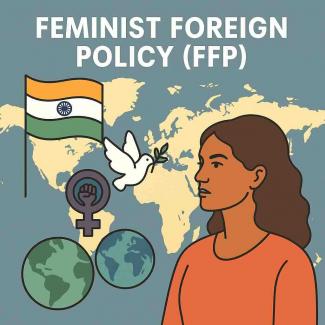Feminist Foreign Policy (FFP): The Scope of Integrating Gender Sensitivity into Indian Foreign Policies
In 2021, during a seminar on gender mainstreaming in India’s foreign policy, India's External Affairs Minister, Dr. S. Jaishankar, emphasized the need for a gender-balanced foreign policy. Jaishankar underscored three crucial aspects: encouraging women's participation in foreign policy issues, integrating women's interests into policy frameworks, and adopting feminist perspectives.
In her seminal paper "The Gender and Human Security Debate" (2009), Anuradha Chenoy highlights that national issues such as security, economic development, and environmental crises disproportionately impact marginalized groups. Thus, foreign policies should integrate women's interests, given their historical marginalization, to counter humanitarian crises effectively and pursue inclusive resolutions.
Statistical data reveal women's significant underrepresentation in India's diplomatic cadre. Women constitute merely 16% of the Indian Foreign Service (IFS) and occupy just 18% of senior diplomatic positions worldwide (Panicker, 2021). Such figures illustrate the acute absence of women from policy-making processes and underline the urgency of integrating feminist perspectives reflective of India's socio-economic and cultural diversity. This article thus examines the trajectory of Feminist Foreign Policies (FFPs) globally and explores their applicability within the Indian context.
What is Feminist Foreign Policy?
Lyric Thompson, Spogmay Ahmed, and Tanya Khokhar (2021), in a comprehensive definition developed for the International Centre for Research on Women, encapsulate feminist academic consensus on FFP objectives. They define feminist foreign policy as an approach prioritizing peace, gender equality, and environmental integrity, emphasizing the disruption of colonial, racist, and patriarchal structures and promoting human rights universally. It insists on coherence across all governmental domains and actively engages with feminist activists and movements, domestically and internationally.
Dr. Tishya Khillare (2023) identifies key objectives for policymakers based on this definition:
- Prioritize peace, gender equality, environmental integrity, and human rights.
- Engage diverse stakeholders, both state and non-state actors.
- Mandatorily adopt intersectional approaches.
- Maintain consistency across foreign policy domains (aid, trade, defense, environment, immigration) and policy implementation levels.
Several nations, including Sweden (despite recently rescinding the FFP label), Canada, France, Germany, Luxembourg, Mexico, Mongolia, the Netherlands, Norway, and Spain, have pioneered feminist approaches. Emerging adopters like Chile, Ireland, Liberia, Libya, and Scotland also provide valuable frameworks. Their policies emphasize women's rights, representation, and resource allocation, targeting women's participation in conflict resolution, political decision-making, economic empowerment, and sexual and reproductive health. Moreover, international bodies, including the United Nations (UN), have increasingly incorporated gender-sensitive frameworks within their Security Council Resolutions (UNSCR).
Why adopt Feminism within Foreign Policy?
The foundational question, "What about women?" prevalent in Feminist International Relations, urges academics and policymakers to employ gender-sensitive analyses of geopolitical issues. Recognizing gender as a social construct necessitates political action toward inclusivity, not as the exclusion of men, but as an equitable response to marginalization. Additionally, feminist approaches advocate intersectionality, addressing compounded discrimination due to race, caste, and class.
Maria Stern and Marysia Zalewski highlight the necessity of theorizing "masculinity" to challenge conventional boundaries in international politics. They caution against "feminist fatigue," wherein gender perspectives become marginalized or superficially integrated, especially in militarized national security debates (Chenoy, 2009). Consequently, incorporating feminist goals within foreign policy emerges as imperative for addressing humanitarian crises effectively.
India's External Affairs Minister, Dr. Jaishankar, also noted the contextual challenges of directly replicating foreign feminist models due to diverse cultural and historical traditions. He stressed the necessity for an organically developed, culturally sensitive feminist foreign policy framework tailored specifically for India.
It is crucial for India, as a rising geopolitical force, particularly within South-South cooperation frameworks, to institutionalize gender-sensitive domestic and international policies. Domestically, this would entail not merely legislative quotas but creating environments conducive to women's meaningful participation in policy-making, addressing socio-economic barriers preventing women’s participation in diplomatic and political spheres. Despite reserving 33% of parliamentary seats for women, actual representation is only 14.36% (Khillare, 2023).
Enhanced representation of women within the Indian Foreign Service would support the formulation of intersectional and inclusive foreign policies, positively influencing India's global engagements. Swati Parashar (2021) notes that an Indian FFP should progressively build capabilities to address local, regional, and global gender issues comprehensively.
Historically, India's foreign policies emphasized ethical and diplomatic approaches, evident during the Independence movement and the Non-Aligned Movement during the Cold War. Thus, introducing feminist principles in contemporary geopolitical strategies would align with India's historical diplomatic ethos. Specific recommendations to integrate feminist approaches in diplomatic strategies include:
- Incorporating gender-disaggregated data collection and inclusive planning in Humanitarian Aid and Disaster Relief (HADR).
- Promoting women's economic empowerment within Economic and Development Cooperation frameworks.
- Developing gender-sensitive policies addressing climate change, recognizing women's disproportionate vulnerability, including increased risks of domestic violence linked to environmental crises.
Unlike other global FFP models, India's feminist approach should be transformative. It should foster structural changes within governmental and non-governmental systems, emphasizing financial support, social empowerment, and reduced reliance on militaristic interventions, which traditionally reinforce gendered stereotypes.
Conclusion
Integrating gender-sensitive human rights into policy-making can significantly enhance women's representation in geopolitical discourses, driving equitable global influence. As India continues to strengthen its geopolitical stature, adopting feminist foreign policies emerges not just as beneficial but essential. This approach ensures India's role as an inclusive, impactful global actor, substantially contributing to global peace, gender equality, and sustainable development. Indeed, Feminist Foreign Policies represent the future trajectory of India's diplomacy.
References
Chenoy, A. M. (2009). The gender and human security debate. In IDS Bulletin (Vols. 40–40, Issue 2). https://doi.org/10.1111/j.1759-5436.2009.00019.x
Khillare, T. (2023). The Feminist Foreign Policy Agenda: What is It and Why Should India Engage with It? https://in.boell.org/en/feminist-foreign-policy01
Panicker, L. (2021, August 7). Indian foreign policy needs more women. Hindustan Times. https://www.hindustantimes.com/opinion/indian-foreign-policy-needs-more…
Thompson, L. and Clement, R. (2019). Defining Feminist Foreign Policy. International Center for Research on Women, https://www.icrw.org/wp-content/uploads/2019/04/ICRW_DefiningFeministFo…
